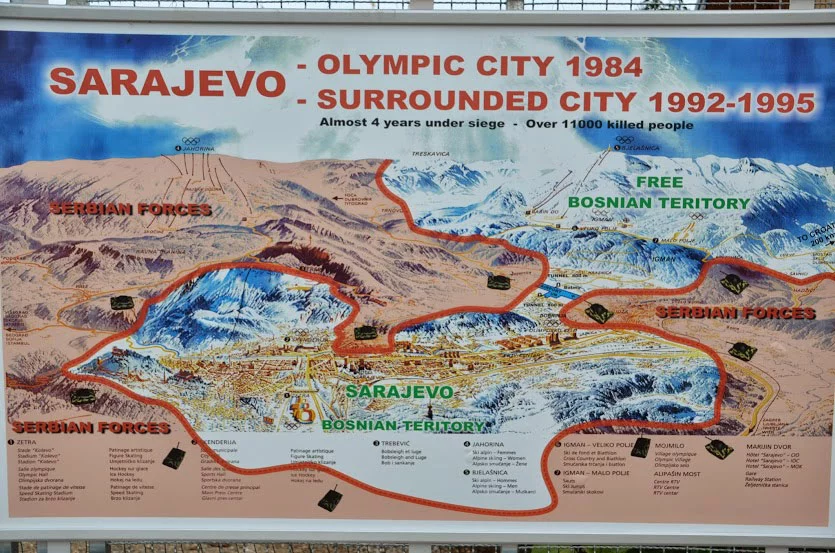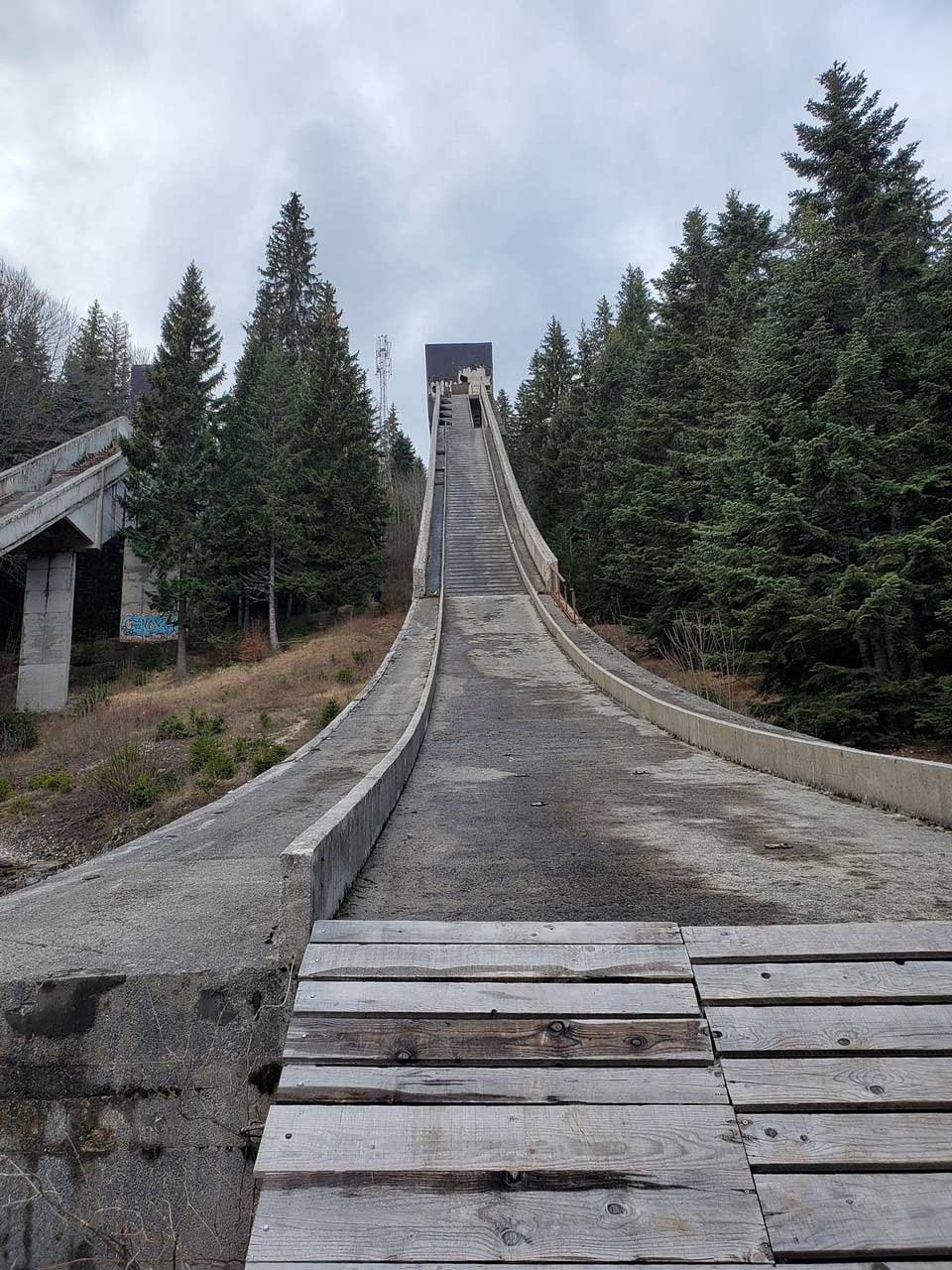10 hours
Daily Tour
Unlimited
English
Join us on a unique journey through the Rise and Fall of Yugoslavia! Nation that once united six countries and stood as one of the most developed communist states in the world. Our tour delves into the echoes of its complex history, exploring key sights like Tito’s Bunker, Ski Jumps from the 1894 Winter Olympics and Tunnel of Hope museum.
Opening Tito’s bunker heavy doors unveils a new world. A testament to Cold War readiness or fear, depending on perspective. The underground fortress, most expensive of its time, doubles as a modern art gallery and military facility. It’s a synergy of army and art.
During the Sarajevo Winter Olympics, joy filled Sarajevans and all Yugoslav people. Ski jumps and a Bobsleigh track became symbols of pride. Sadly, within a decade, they transformed from emblems of joy to relics of destruction. New roles emerged, making them the world’s most uniquely repurposed structures.
The Tunnel of Hope museum is crucial for understanding the siege of Sarajevo and the War in Yugoslavia. It served as a lifeline during the longest siege in modern history. Amazingly, an 800-meter-long tunnel aided over 200,000 people to survive.
If You are short on time but eager to learn about the Rise and Fall of Yugoslavia you can chose our shorter tour. A 4-hour Bosnian and Yugoslav War Tour with Tunnel of Hope is shorter but still enriching experience.

It takes about one hour drive to Konjic. During the drive, the tour guide will describe various areas of the city of Sarajevo and region, highlighting locations and structures significant to the storyline. You will be able to identify the demolished structures from the video presentation at the Tunnel of Hope Museum. Panoramic tour includes passing by:

Hidden away in Konjic is a remarkable secret of the former Yugoslavia! Tito's bunker, a meticulously preserved enclave that ranks as the third most expensive project in the Yugoslav history, carrying a staggering price tag of 4.6 billion US dollars
The construction of the bunker, code-named "Istanbul" during its creation, unfolded in complete secrecy between 1953 and 1979. Serving as a concealed haven, it had the capacity to shelter 350 of the highest political and military officials from the former Yugoslavia. In the face of potential nuclear threats, this subterranean city stood ready to harbor and facilitate the establishment of a new state. Tito's bunker thus represents not only a colossal financial investment but also a captivating chapter in the region's history, shrouded in secrecy and historical significance.

Sarajevo, four decades post the Olympic Games in Yugoslavia, paints a somber picture with the remains of the once-thriving Olympic arenas. Among the ruins stands the image of the ski jumps on Igman, a sporting marvel that only a handful of countries, then and now, could boast about.
These ski jumps, with slopes measuring 112 and 90 meters, were once the stage for adrenaline-fueled moments, where jumpers soared through the air. Today, all that remains are two desolate boards, stark symbols of the disuse that has befallen these once-majestic structures.
Now, the big question: Will we ever see athletes back on those jumps? Honestly, it doesn't look likely. But there they stand, like quiet monuments, reminding us of the powerhouse days of Yugoslavia's sports scene.

During the Siege of Sarajevo, one of the longest and deadliest in modern history, a lifeline emerged beneath the city streets, known today as the Tunnel of Hope. This secret tunnel underneath UN controlled airport was just 1 meter wide and 1.6 meters high. It stretched for nearly 800 meters, connecting the besieged city to the outside world. Constructed in 1993 by Bosnian soldiers and volunteers, this engineering marvel allowed food, supplies, and in average 4000 people every day to pass beneath the airport runway. The Tunnel of Hope Museum, established in 1996, now preserves this remarkable piece of history, displaying photographs, artifacts, and the original tunnel entrance, offering visitors a profound insight into the courage and resilience of Sarajevo's people during those challenging times. If not for Tunnel, Bosnia and Herzegovina would not exist today.

Hidden in the Trebevic mountain lies a unique relic of the 1984 Winter Olympics: the abandoned bobsleigh track. This concrete marvel, originally designed for Olympic athletes to hurtle down icy slopes, has taken on a new life as a canvas for urban art and a symbol of Sarajevo's resilience. Constructed in the Trebević Mountains, the track was part of the city's vibrant sporting history. However, during the brutal Siege of Sarajevo in the 1990s, it fell into disrepair, enduring artillery fire and neglect. Today, graffiti artists from around the world have transformed it into a mesmerizing open-air art gallery. With our guide hike up to the track and explore its colorful curves. NOTE: Remember to bring camera!

Hotel Osmice was constructed high above Sarajevo on the slopes of Trebevic Mountain, and now it lies in ruins. What was once a popular hangout for locals is now a somber reminder of the city's destruction in the 1990s. The enemy forces used it as a vantage point to overlook the city of Sarajevo as they bombarded it with artillery. An easy to miss location recently has been popularized by our agency.

Established in the late 17th century, the Jewish Cemetery is one of the oldest Jewish burial sites in Europe. It served as the final resting place for generations of Jewish families who called Sarajevo home. UNESCO-protected Bosnian tombstones known as "Stećak" served as inspiration for majority of grave markers. Tombstones engraved with Hebrew and Ladino, provide a glimpse into the rich cultural heritage of the Jewish community in Sarajevo. Unfortunately during the recent war it was used as sniper nest.

Once a strategic defense point overlooking Sarajevo, the Yellow Fortress has transformed into an emblematic spot for both locals and tourists. Its curious name comes from the color of its stone, which seems to radiate golden hues during the setting sun. Short walk to the top is rewarded with panoramic views of Sarajevo's red-roofed old town, the Miljacka River, and the surrounding mountains. The Soldiers Cemetery, located beneath the forth, is the resting place of Alija Izetbegovic, the first president of Bosnia and Herzegovina. His last wish was to be surrounded by fellow soldiers.